new posts in all blogs
Viewing: Blog Posts Tagged with: Multicultural books, Most Recent at Top [Help]
Results 26 - 50 of 80
How to use this Page
You are viewing the most recent posts tagged with the words: Multicultural books in the JacketFlap blog reader. What is a tag? Think of a tag as a keyword or category label. Tags can both help you find posts on JacketFlap.com as well as provide an easy way for you to "remember" and classify posts for later recall. Try adding a tag yourself by clicking "Add a tag" below a post's header. Scroll down through the list of Recent Posts in the left column and click on a post title that sounds interesting. You can view all posts from a specific blog by clicking the Blog name in the right column, or you can click a 'More Posts from this Blog' link in any individual post.

By:
jilleisenberg14,
on 3/23/2015
Blog:
The Open Book
(
Login to Add to MyJacketFlap)
JacketFlap tags:
multicultural books,
Educators,
Educator Resources,
Common Core State Standards,
CCSS,
culturally relevant literature,
ELA common core standards,
culturally responsive literature,
diverse literature,
Add a tag
We hear over and over again from teachers across the country how they want to infuse more culturally responsive and relevant texts into their district or school-mandated curriculum.
It’s challenging to do, but what if we had some resources to share to help you out?
First, read: If you haven’t read this article from Reading Teacher, here’s your chance. Authors Fenice Boyd, Lauren Causey, and Lee Glada offer teachers great suggestions for culturally diverse literature that addresses Common Core standards in this Reading Teacher article (PDF).
What is “culturally relevant teaching?” Heather Coffey at LEARN NC, a program of the UNC School of Education, shares the history and theory.

Here are some places teachers are finding culturally relevant / responsive texts and (just as vital) ready-to-go lesson plans. Check out:
- The Teachers College Inclusive Classrooms Project (TCICP) offers concrete examples for teachers to make their classrooms more inclusive, such as the Culturally Relevant Curriculum practice and inquiry. These were created by (NYC) teachers for teachers
- Utah public school teachers created these multicultural lesson plans during their Center for Documentary Expression and Art course, “Multiculturalism and Storytelling,” available through the Utah Education Network (UEN) lesson library
- The Lewis Library at the Loyola University Chicago Libraries has created this amazing visual resource for teachers at its School of Education to find multicultural books right for their students and instructional strategies
- POV at PBS provides lessons exploring multiculturalism to pair with its films for grades 6 and up
- TeachPeaceNow has literature-based lesson plans covering social justice topics to include in your curriculum
- ArtsEdge, an education program of The Kennedy Center, has written detailed ready-to-implement lessons on American culture and comparing cultural holidays (just to highlight a few)
- TeachableMoment from Morningside Center for Teaching Social Responsibility offers inquiry-oriented lessons on current issues and social and emotional learning
For even more ideas for discovering diverse literature that’s will pair with your curriculum, check out A More Diverse Reading List: Resources to Expand CCSS-aligned Texts compiled by Lee & Low Books.
Where do you recommend teachers find lessons plans that align with their curriculum and incorporate diverse literature? Share with us!
Jill Eisenberg, our Senior Literacy Expert, began her career teaching English as a Foreign Language to second through sixth graders in Yilan, Taiwan as a Fulbright Fellow. She went on to become a literacy teacher for third grade in San Jose, CA as a Teach for America corps member. She is certified in Project Glad instruction to promote English language acquisition and academic achievement. In her weekly column at The Open Book, she offers teaching and literacy tips for educators.

By:
rgarcia406,
on 2/19/2015
Blog:
The Open Book
(
Login to Add to MyJacketFlap)
JacketFlap tags:
Diversity 102,
Diversity,
Publishing 101,
Book Lists by Topic,
Uncategorized,
African/African American Interest,
Asian/Asian American,
Awards,
Dear Readers,
Lee & Low Likes,
New Voices/New Visions Award,
Diversity, Race, and Representation,
Race,
Tu Books,
Native American,
Race issues,
Teens/YA,
writing contests,
multicultural books,
aspiring authors,
author advice,
Latino/Hispanic/Mexican,
Add a tag
Getting your book published is difficult, and unfortunately it tends to be much harder when you’re a Person of Color. While there are more diverse books being published, there’s still a lot of work to do!
Fortunately there are awards and grants out there help writers of color achieve their publication dreams.
We’ve created a list of awards and grants to help you get started!
New Voices Award – Established in 2000, is for the unpublished author of color for a picture book manuscript.
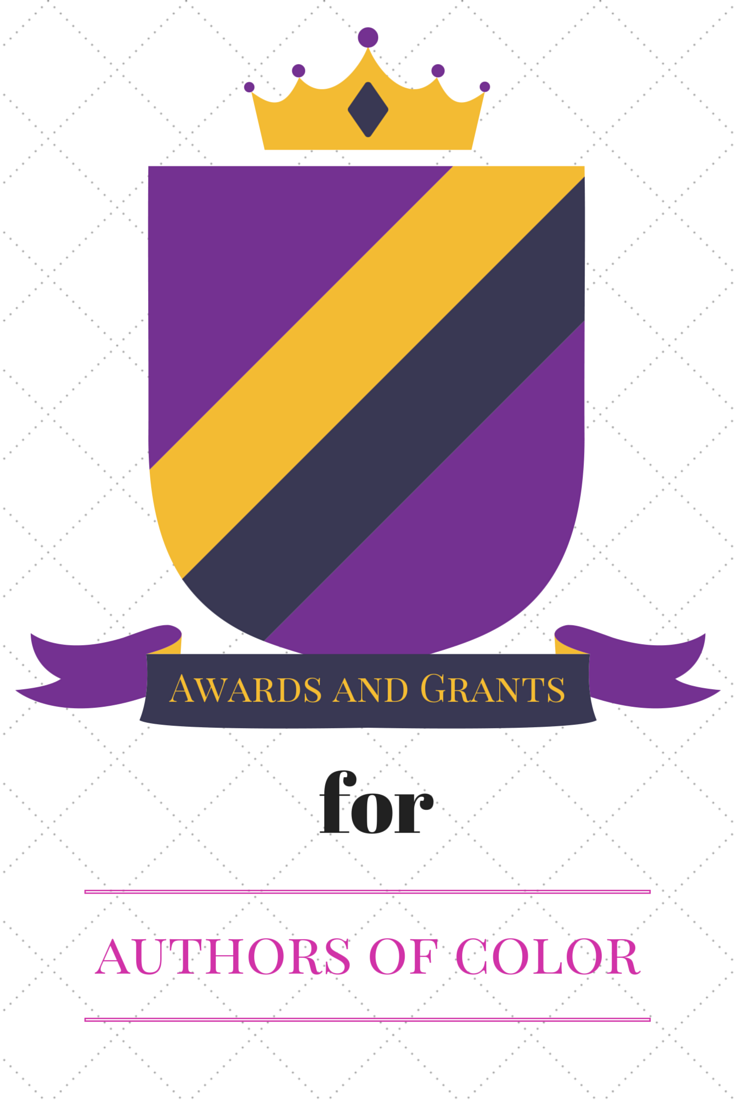 New Visions Award – Modeled after LEE & LOW’s New Voices Award, this award is for Science Fiction, Fantasy, or Mystery middle grade or YA novels.
New Visions Award – Modeled after LEE & LOW’s New Voices Award, this award is for Science Fiction, Fantasy, or Mystery middle grade or YA novels.
SCBWI Emerging Voices Grant – This award is given to two unpublished writers or illustrators from ethnic and/or cultural backgrounds that are traditionally under-represented in children’s literature in America and who have a ready-to-submit completed work for children.
The Angela Johnson Scholarship from Vermont College of Fine Arts – This scholarship is for new students of color of an ethnic minority for VCFA’s MFA program.
Vaunda Micheaux Nelson Scholarship from Hamline College – “Annual award given to a new or current student in the program who shows exceptional promise as a writer of color.”
We Need Diverse Books Short Story Contest - This short story contest was inspired by Walter Dean Myers’ quote, “Once I began to read, I began to exist.”
The Scholastic Asian Book Award – This award is for Asian writers writing books set in Asia aimed at children 6-18 years of age.
Octavia E. Butler Memorial Scholarship Fund – This fund enables writers of color to attend the Clarion writing workshops where writer Octavia Butler got her start.
SLF Diverse Writers and Diverse Worlds Grants – These grants are new works and works in progress. The Diverse Writers Grant focuses on writers from underrepresented and underprivileged backgrounds, and the Diverse Worlds Grant is for stories that best present a diverse world, regardless of the author’s background.
Eleanor Taylor Bland Crime Fiction Writers of Color Award – This one time grant is awarded to an emerging writer of color of crime fiction.
NYFA Artists’ Fellowships – These fellowships are for residents of New York State and/or Indian Nations located in New York State.
Golden Baobab Prizes for Literature – These annual awards recognize emerging African writers and illustrators.
The Sillerman First Prize for African Poets – This prize is for unpublished African poets.
What other awards and grants do you recommend for authors of color?

By:
Stacy Whitman,
on 2/12/2015
Blog:
The Open Book
(
Login to Add to MyJacketFlap)
JacketFlap tags:
writing advice,
Uncategorized,
diversity,
writing,
recap,
multicultural books,
aspiring authors,
Writer Resources,
author advice,
Tu Books,
Diversity in YA,
Diversity, Race, and Representation,
Diversity 102,
Add a tag
Over the weekend (Feb. 7), I taught a breakout session at the Annual Winter Conference of the Society of Children’s Book Writers and Illustrators here in New York, NY. We were discussing how to write for a diverse audience. My main focus was on helping the audience to remember that no matter what you’re writing, your audience will always be diverse. Too often, writers think that there’s a dichotomy–that there are “multicultural books” that are read by kids of color, and that “everyone else” (meaning, white kids) read “mainstream” (meaning, white) books.
This just isn’t the case. Readers tend to read widely, and kids of color are just like their white peers, reading the most popular books, the books assigned to them in schools, and whatever else they happen to come across that sounds interesting to them.
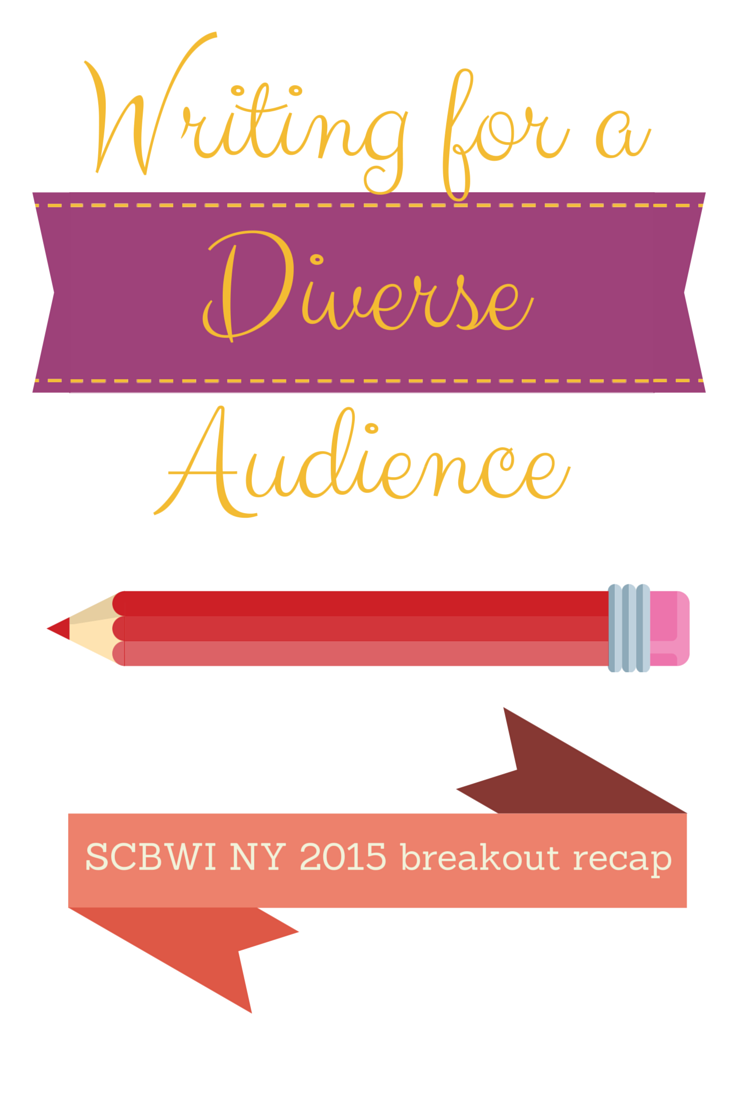 Below are the links and a few notes from the handout I gave to writers at the conference, with a few annotations to clarify what we were talking about. I hope it is a useful resource when you’re thinking of writing for a diverse audience (i.e., when you’re thinking of writing–period!). If you have any further ideas–or links where writers can go further in depth–please add them in the comments.
Below are the links and a few notes from the handout I gave to writers at the conference, with a few annotations to clarify what we were talking about. I hope it is a useful resource when you’re thinking of writing for a diverse audience (i.e., when you’re thinking of writing–period!). If you have any further ideas–or links where writers can go further in depth–please add them in the comments.
Other coverage: SCBWI Conference Blog
Other sessions on the same topic: Newbery Medalist Kwame Alexander’s breakout session on writing diverse books
Seven Essentials You Need to Know about Writing for a Diverse Audience
- Don’t feel “forced” to write diversity, but remember your readers are diverse
- If your real-life world isn’t diverse, if you don’t know any people of color, if you don’t know how to write diverse characters without relying on stereotypes, you don’t have to feel pressured to do so.
- And don’t feel like you need to come in and “save” anyone—come in from a position of equality and seeking equity.
- However, your world is likely more diverse than you think.
- Often, people of color and Native Americans are most hurt by passing comments in books that aren’t “about” POC at all. (Debbie Reese’s blog has many examples of this.)
- Don’t be afraid to discuss race. If you’re new at this, do a lot of listening.
- You need to know about power dynamics
- What is a microaggression?
- White (and other) privilege
- Writing across POC cultures—what is the individual dynamic?
- Expand your definition of “diversity.”
- Diversity is not just about race, religion, class, etc. It is often about how many different identity markers come together to create a specific experience. Here’s a basic definition of intersectionality. Think about how it affects your characters.
- Intersections happen across 11 lenses, according to Teaching Tolerance:
- race
- ethnicity
- language
- immigration
- religion
- gender identification
- sexual orientation
- class
- ability
- age
- place
- Social media doesn’t have to be a distraction.
- Check out these excellent feeds & related blogs for listening and learning (many also have great diverse book lists!):
- Lee & Low and Tu Books: blog, @tubooks, @leeandlow
- Diversity in YA, @diversityinYA
- We Need Diverse Books, @diversebooks
- Rich in Color, @richincolor
- American Indians in Children’s Literature, @debreese
- Black Girl Nerds, @blackgirlnerds
- Disability in Kidlit, disabilityinkidlit.tumblr.com, @disabilityinlit
- Twitter searches: #WeNeedDiverseBooks, #BlackLivesMatter
- Angry Asian Man
- Disgrasian: @disgrasian
- Ebony Elizabeth Thomas & The Dark Fantastic, @ebonyteach
- Ta-Nahisi Coates, @tanehisicoates
- Racialicious, racialicious.tumblr.com, @racialicious
- Colorlines, @colorlines
- Mitali Perkins, @mitaliperkins
- Cynthia Leitich Smith & Cynsations, @CynLeitichSmith
- NPR Code Switch, @nprcodeswitch
- Roxane Gay, @rgay
- In your writing, seek both the universal & the specific.
- Universal stories appeal to a broad swath of readers: characters dealing with parents, love stories, stories of loss—these are all stories of the human condition.
- Specific details make your story richer.
- If you are writing cross-culturally, do your research. Debbie Reese has an excellent guide on seeking a cultural expert in Native American issues. Look for similar information on the culture you’re writing about.
- And write a good book:
- the most important thing about a diverse book is the same thing as for all books. What matters most:
- Characterization
- Plot
- World-building
- Pacing
- Age-appropriate content (though not shying away from edgy topics)
- Concept
- Contextual clues are better than exposition of culture.
- Show, don’t tell!
- Remember that your audience includes cultural insiders and outsiders. Balance enough information for outsiders with the possibility of boring insiders with too much basic everyday information.
- School visits are a great way to reach diverse students.
- At the beginning of your career, be willing to do school visits or Skype visits for a low honorarium, until you can build up your resume and network with more teachers.
- Keep in mind that schools with a high percentage of diverse students are often the most underfunded. They may not have a budget for an honorarium, but may be able to purchase books for students to compensate.
 Stacy Whitman is Editorial Director and Publisher of Tu Books, an imprint of LEE & LOW BOOKS that publishes diverse science fiction and fantasy for middle grade and young adult readers.
Stacy Whitman is Editorial Director and Publisher of Tu Books, an imprint of LEE & LOW BOOKS that publishes diverse science fiction and fantasy for middle grade and young adult readers.

By:
rgarcia406,
on 2/3/2015
Blog:
The Open Book
(
Login to Add to MyJacketFlap)
JacketFlap tags:
Awards,
ALA,
children's books,
Book News,
Uncategorized,
Diversity,
Pat Mora,
Coretta Scott King Award,
Race,
multicultural books,
African/African American Interest,
Dear Readers,
Latino/Hispanic/Mexican,
Lee & Low Likes,
Diversity, Race, and Representation,
Diversity 102,
recap post,
Little Melba,
Little Melba and her Big Trombone,
Arbuthnot Honor,
Día,
Water Rises,
Water Rolls,
Add a tag
Yesterday was the ALA Youth Media Awards, or the “Oscars of Children’s Literature” as they’re sometimes called. It was a big day for diversity. Diverse books and authors were honored across the board and we couldn’t be happier.
Little Melba and Her Big Trombone, written by Katheryn Russell-Brown and illustrated by Frank Morrison, received the Coretta Scott King Honor for Illustration. Little Melba follows the life of famed trombonist, composer, and arranger Melba Liston who broke through racial and gender barriers to become one of the great unsung heroes of jazz.
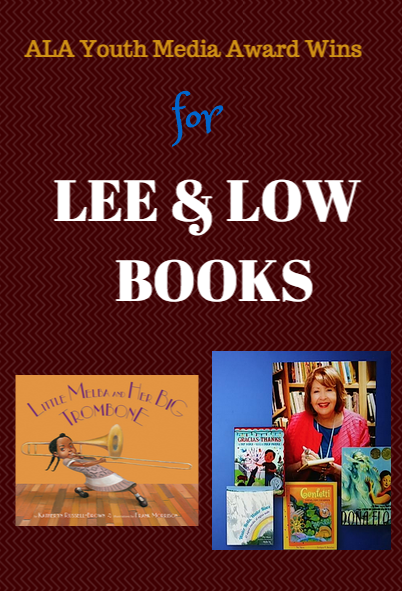
Pat Mora, author of Water Rolls, Water Rises/El agua rueda, el agua sube and many other award-winning titles, won the 2016 May Hill Arbuthnot Honor Lecture Award! This award recognizes an author, librarian, or children’s lecturer who will then present a lecture at a winning host site. In addition to her writing, Pat Mora is also a literacy
advocate. She created Día, a day that celebrates children and the importance of reading.
Congratulations to all the titles honored at the ALA Youth Media Awards!

As a reading and play advocate, I am always looking for fun and innovative ways to shine the spotlight on new children’s literacy and inspire families to pull books off of shelves and stories off of pages.
So early last year, I decided to create a fun guidebook to do just THAT.
To create this Multicultural Books & Activities for Kids, I reached out to some of the brightest bloggers and asked them to pick a book that is meaningful to them, review it and create a fun activity to go along with it. The following is a line-up consisting of not only passionate reading advocates, but some of the most creative writers and bloggers I know.
The result? This guidebook is packed full of 17 great book ideas for kids and offers up not only suggestions to keep young minds reading, but matching activities and extensions inspired by the books. This guide is designed to keep families engaged in the wonder and magic that can be found within the pages of a book and offer suggestions for diversity in children’s literature. The good news is that I am giving this e-book away for FREE! Yes, you heard me; FREE.
Jump Into a Book’s
By Valarie Budayr

Some of the books used in the reviews and activities are:
- Stand Tall, but Read All Around!
{by Shannon Medisky}
- Read Around the World Summer Reading Series
{Guest post from Multicultural Kid Blogs}
- Kid Writing and Biographies: Brown Girl Dreaming by Jacqueline Woodson
{Guest Post from The Unconventional Librarian Pam Margolis}
- Down Under Calling by Margot Finke Book Review and Penpal Activity
{A Multicultural Children’s Book blog post from Jump Into a Book}
- Anna Hibiscus by Atinuke
{Guest Post by Sprout’s Bookshelf}
- Read a Book; Travel the World & Make a Wish
{Guest Post from Gladys Elizabeth Barbieri}
- Fiesta Fiasco by Ann Whitford Paul
{Guest Post by Frances from Discovering the World Through Her Son’s Eyes}
- If you were Me and Lived in…by Carole P. Roman
- {Guest Post from Squishable Baby}
- Discovering The Cree Culture in America-Wild Berries by Julia Flett Review & Activity!
{Guest Post from Felicia at Stanley and Katrina}
- TOMB OF SHADOWS (7 Wonders Book III)
{Guest Post from This Kid Reviews Books}
- Cooking with Books: Lucky Birthday Noodles
{Guest Post from Jodie @ Growing Book by Book}
- A Peek into Thailand
{Guest Post from Stephanie Kammeraad of Mama-Lady Books}
- A Chair for My Mother Book Review & Activity
- {Guest Post from Vicki Arnold}
- The Magic Poof Review and Activity
{Guest Post by Stephen Hodges}
- Grandfather Tang’s Story: Storytelling with Tangrams
{Bookjump by Valarie Budayr}
And so much more! Ready for a FREE GIFT that will give your family hours of reading fun and activity? I thought so 
This e-book will only be available for a short time so grab your copy HERE.
Read On!
The post My Free Gift To YOU-Read Your World Multicultural Books Activities for Kids Guide appeared first on Jump Into A Book.

With the winter months upon us, I feel this is a great time for readers of all ages to snuggle in with a good book. I have been blessed with tons of amazing books titles for kids over these last few months and I want to get these books into the hands of young readers. SO, for the next three months Jump Into a Book will be hosting a book giveaway every Wednesday! Some giveaways will be a single title, some will be a “Book Bundle,” but all will be books that your readers will love and cherish. I think these books will also make great gifts as well! Here’s what we are giving away this week (NOTE: All of these books are physical books, not Kindle versions).
This week I am giving away some wonderful books courtesy of Wisdom Tales Press! As you may already know, I a huge fan of Wisdom Tales and their high-quality multicultural books for kids. Wisdom Tales is also one of our Platinum Sponsors for Multicultural Children’s Book Day and I couldn’t be more grateful. They were also kind enough to supply me with FOUR gorgeous books to giveaway this week! Good luck!
Read my book review of this wonderful book (with activities!)
HERE.The Dreidel That Wouldn’t Spin: A Toyshop Tale of Hanukkah by Martha Seif Simpson and Illustrated by Durga Yael Bernhard
“This dreidel doesn’t work!” the father had cried. “What do you mean? How can a dreidel not work?” the shopkeeper asked. It was certainly the most beautiful spinning top the shopkeeper had ever seen, with magical golden letters on its sides. But it just would not spin for two spoiled children who insisted on owning it! Later, the shopkeeper decides to try it one last time: would it spin for another child, one who carried the true spirit of Hanukkah in his heart?
Read my book review with companion activities
HERE.Eating bamboo shoots with chopsticks three feet long? Impossible, you say. Not if you are a playful panda and learn to share and work together with your friends! In her beautifully illustrated new book, award-winning author, Demi, presents ten classic animal stories, each containing important moral lessons for little hearts and minds to absorb. Cunning kitties, helpful hummingbirds, talkative turtles, and hasty hedgehogs, all bring these meaningful fables to life. Through her magical illustrations and whimsical storytelling, Demi teaches the importance of being humble, the dangers of being too proud, the importance of generosity and sharing, and how everyone, no matter how small, has a part to play in life.
DETAILS ON GIVEAWAY:
- ONE winner each receive a one copy of all three books. Giveaway begins December 10th and ends December 17th, 2014
- Prizing & samples courtesy of Audrey Press
- Giveaway open to US addresses only
- ONE lucky winner will win one copy of each book listed above.
- Residents of USA only please.
- Must be 18 years or older to enter.
- One entry per household.
- Staff and family members of Audrey Press are not eligible.
- Grand Prize winner has 48 hours to claim prize.
- Winner will be chosen via Rafflecopter on December 18th
a Rafflecopter giveaway
The post Three Months of Book Giveaways! Four Enchanting Tales from Wisdom Tales Press! appeared first on Jump Into A Book.

By:
jilleisenberg14,
on 12/8/2014
Blog:
The Open Book
(
Login to Add to MyJacketFlap)
JacketFlap tags:
reading comprehension,
close reading,
Educator Resources,
Common Core State Standards,
CCSS,
ELA common core standards,
ELL/ESL and Bilingual Books,
Guest Blogger Post,
children's books,
diversity,
Reading Aloud,
Race,
multicultural books,
Educators,
Add a tag

 Emily Chiariello is a Teaching and Learning Specialist with Teaching Tolerance. She has 15 years’ experience as a classroom teacher, professional development and curriculum designer in public, charter and alternative school settings, as well as with non-profit organizations. She holds a master’s degree in philosophy and social policy and is certified in secondary social studies.
Emily Chiariello is a Teaching and Learning Specialist with Teaching Tolerance. She has 15 years’ experience as a classroom teacher, professional development and curriculum designer in public, charter and alternative school settings, as well as with non-profit organizations. She holds a master’s degree in philosophy and social policy and is certified in secondary social studies.
Here she discusses Teaching Tolerance’s new curriculum tool, “Project Appendix D,” that empowers educators to identify texts that both meet the demands of the Common Core Standards and reflect the world in which our students live. This blog post was originally posted at the Teaching Tolerance blog.
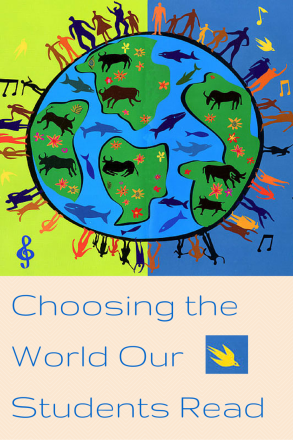
by Emily Chiariello
Does the Common Core limit what texts teachers can use? While many people think so, we don’t. Teaching Tolerance believes it is possible—and important—to choose texts that are both rigorous and relevant. Read on to learn about a new approach to text selection: Appendix D: A Tool for Selecting Diverse Texts. This exciting project goes beyond the resources offered in Appendices A and B and offers a new world of possibilities within literacy instruction.
Appendices A and B
Teachers are expected—per the CCSS’s Appendix A—to select more complex texts, teach more nonfiction and ask more text-dependent questions. But do they feel less empowered to choose readings about social justice or to locate texts that reflect the identities and histories of their students and communities? We’re concerned the answer is yes. We know that teachers want texts that mirror their students’ lives. And to achieve equitable outcomes, the Common Core must be implemented in culturally responsive ways that address social emotional learning as well as academic goals. Yet, this kind of implementation is not happening in most districts.
At first glance, one might think that the “Reader and Task” portion of the text selection model in Appendix A makes room for culturally responsive instructional decisions. Instead, there’s only a brief and bland mention of “reader variables”—motivation, knowledge and experiences—ultimately eclipsed by the other two measures: hard Lexile scores (quantitative) and subjective interpretations of meaning and purpose (qualitative).
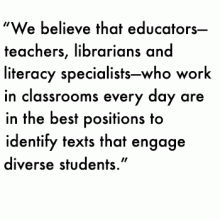 And then there’s the stark imprint of privilege found in the gaps and silences of Appendix B, a list of “text exemplars” that meet the aforementioned approach to text complexity, quality and range. Too many publishers—and districts, too—have interpreted the text exemplars listed in Appendix B as a required reading list.
And then there’s the stark imprint of privilege found in the gaps and silences of Appendix B, a list of “text exemplars” that meet the aforementioned approach to text complexity, quality and range. Too many publishers—and districts, too—have interpreted the text exemplars listed in Appendix B as a required reading list.
Woefully few examples of cultural relevance can be found in “Common Core-aligned” materials and trainings, including Appendix B. Jane M. Gangi, professor of education at Mount Saint Mary College, has analyzed Appendix B and found that, of the 171 texts recommended for children in K-5, only 18 are by authors of color, and few reflect the lives of children of color and children in poverty.
Appendix D
We believe that educators—teachers, librarians and literacy specialists—who work in classrooms every day are in the best positions to identify texts that engage diverse students.
That’s why we’re excited to share our new project: Appendix D: A Tool for Selecting Diverse Texts. Traditionally, tools that support text selection have focused on quantitative and qualitative measures only. But Appendix D promotes a multi-dimensional approach to text selection that prioritizes complexity as well as critical literacy and cultural responsiveness.
Appendix D empowers educators to rely on their knowledge of their students, rather than a prepopulated lists of titles, when selecting texts. The tool walks users through four distinct—but interconnected—text-selection considerations: complexity, diversity and representation, critical literacy, and reader and task. And it’s an editable PDF, allowing folks to document, save and share their text-selection process. (Be sure to download to unlock the editing capabilities.)
So, why a tool and not a list? There are commendable lists out there. Gangi and the Collaborative for Equity Literacy Learning (CELL) assembled an alternative list of multicultural titles, but they are not leveled for teachers to assess text complexity. Others, like publishers LEE & LOW, work to bring more diversity and representation into classroom libraries, and to the task of text selection. However, none of the lists we’ve investigated encompass texts that are both culturally relevant and meet the Common Core’s requirements for complexity. And, unless it is dynamic, any list of diverse books is only as diverse as the person—or people—who made it.
We hope the TT community will use Appendix D to help us grow a dynamic and diverse list of texts based on the four considerations and on the diverse needs of our students. We’ve started with the titles currently found in Perspectives for a Diverse America, our new anti-bias curriculum. In the months to come, as you use the Appendix D tool in your own practice, think of which complex, culturally relevant titles you think your fellow social justice educators would want to know about—and be on the lookout for an invitation to submit your texts to the ever-growing, ever-changing TT community list!
Paulo Freire wrote that, when we read words, we read the world. Don’t we owe it to our students to consider them when choosing those words?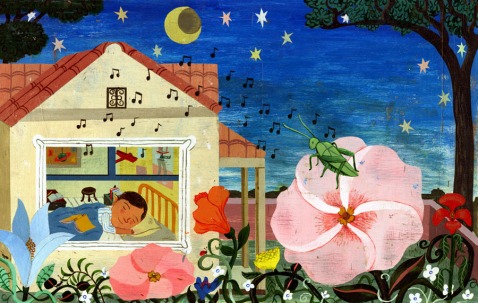
Filed under:
Common Core State Standards,
Educator Resources,
ELL/ESL and Bilingual Books,
Guest Blogger Post,
Race Tagged:
CCSS,
children's books,
close reading,
diversity,
Educators,
ELA common core standards,
multicultural books,
Reading Aloud,
reading comprehension 


By:
jilleisenberg14,
on 11/20/2014
Blog:
The Open Book
(
Login to Add to MyJacketFlap)
JacketFlap tags:
children's books,
holidays,
diversity,
Reading Aloud,
Adoption,
multicultural books,
Educators,
reading comprehension,
Educator Resources,
Multiracial,
Transracial adoption,
Common Core State Standards,
Holidays and Celebrations,
Add a tag
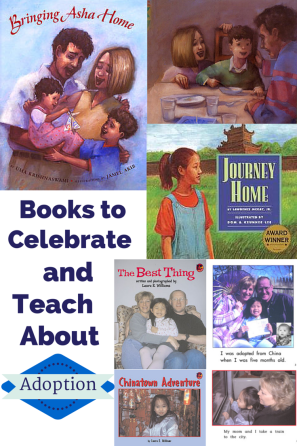
National Adoption Day this November 22 and National Adoption Month this November afford a time to share experiences and reflect on families. Whether you have students who have been adopted or are part of a family considering adopting a child into your home, all children can benefit from learning about adoption. Children are very curious about each other’s families, quick to categorize into groups, and intent to define what makes a family, well, a family.
Picture books provide a medium to discuss, celebrate, and learn about adoption and exploring the definition of “family.”
Book recommendations:
Bringing Asha Home

Journey Home

The Best Thing

Chinatown Adventure

Discussion Questions during and after reading:
- What does “family” mean to you? How might the word mean something different to people?
- What does it mean to be adopted? What might be some challenges for a family with an adopted child or for a child who is adopted? What might be some benefits for a family who adopt a child or for a child who is adopted?
- How is this character’s family similar to and different from your own family?
- How do this character and family share and have fun together? What do you enjoy doing with your siblings and family members?
- How does the character feel at the beginning, middle, and end of the story? How does the main character change from the beginning to the end of the story?
- How would you describe this character’s relationship with his/her parent in the story?
Activities:
- Learn more about the country from which the character is adopted. On which continent is the country located? What countries border this country? What language is spoken there? How many people live in that country? Who are some famous people from that country? Find a recipeof a food from this country to make.
- Share and reflect on this list of famous adoptees or adopters from TeacherVision by Beth Rowen.
- Draw a family portrait of your own family.
- Write a paragraph describing what makes your family unique and why you are proud of your family.
Further reading about adoption:
 Jill Eisenberg, our Senior Literacy Expert, began her career teaching English as a Foreign Language to second through sixth graders in Yilan, Taiwan as a Fulbright Fellow. She went on to become a literacy teacher for third grade in San Jose, CA as a Teach for America corps member. She is certified in Project Glad instruction to promote English language acquisition and academic achievement. In her column she offers teaching and literacy tips for educators.
Jill Eisenberg, our Senior Literacy Expert, began her career teaching English as a Foreign Language to second through sixth graders in Yilan, Taiwan as a Fulbright Fellow. She went on to become a literacy teacher for third grade in San Jose, CA as a Teach for America corps member. She is certified in Project Glad instruction to promote English language acquisition and academic achievement. In her column she offers teaching and literacy tips for educators.
Filed under:
Common Core State Standards,
Educator Resources,
Holidays and Celebrations Tagged:
Adoption,
children's books,
diversity,
Educators,
holidays,
multicultural books,
Multiracial,
Reading Aloud,
reading comprehension,
Transracial adoption 


By:
rgarcia406,
on 10/28/2014
Blog:
The Open Book
(
Login to Add to MyJacketFlap)
JacketFlap tags:
bilingual books,
multicultural books,
LGBT,
Children's Book Press,
African/African American Interest,
Asian/Asian American,
Latino/Hispanic/Mexican,
Lee & Low Likes,
Activities and Events,
Book Lists by Topic,
Diversity 102,
and Representation,
Add a tag
Today is Mix It Up At Lunch Day, an annual day started by Teaching Tolerance over a decade ago to encourage kindness and reduce prejudice in schools by encouraging students to sit and have lunch with someone new, one day out of the year. Teaching Tolerance offers some great resources to help schools celebrate Mix It Up At Lunch Day, and we thought we’d add our own list of recommended books that encourage kindness, giving, bravery and open-mindedness!
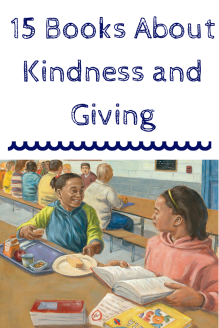
- Lend a Hand: Poems About Giving written by John Frank and illustrated by London Ladd- A collection of poems showing the many ways individuals can make differences.
- Antonio’s Card written by Rigoberto González and illustrated by Cecilia Álvarez – Antonio’s classmates make fun of Leslie, Antonio’s mother’s partner because of her paint-spattered overalls. Antonio decides to make a card for his mother and her partner.
- First Come the Zebra by Lynne Barasch – Abaani, a Maasai boy, sees a Kikuyu boy, Haki, tending a new fruit and vegetable stall alongside the road and they take an immediate dislike to each other. A short while later, a dangerous situation arises near Haki’s stall and Abaani and Haki must overcome their differences and work together.
- King for a Day written by Rukhsana Khan and illustrated by Christiane Krömer – Malik wants to become the king of the kite festival, Basant. Using his kite Falcon, Malik becomes the king of Basant! When he sees a bully take a kite from a girl, Malik uses Falcon to give her a nice surprise.
- Grandfather Counts written by Andrea Cheng and illustrated by Ange Zheng – Gong Gong, Helen’s grandfather who only speaks Chinese, moves in with her family. Helen is worried about not being able to speak to him. She hears him counting train cars in Chinese, and she reciprocates by showing him how to count in English.
- Sam and the Lucky Money written by Karen Chinn and illustrated by Cornelius Van Wright and Ying-Hwa Hu – Sam receives lucky money–red envelopes called leisees (lay-sees), from his grandparents that he can spend any way he wants. When he doesn’t have enough money to buy what he wants, Sam
 instead decides to give his money to a homeless man.
instead decides to give his money to a homeless man.
- Birthday in the Barrio written by Mayra Lazara Dole and illustrated by Tonel – Chavi’s friend Rosario wants to have a quinceñera (sweet 15), but her family can’t afford it. Chavi gathers people in the barrio (neighborhood) and throws Rosario a birthday party in the community center.
- Brothers in Hope written by Mary Williams and illustrated by R. Gregory Christie – When eight-year-old Garang’s village in southern Sudan is destroyed, he walks thousands of miles with many other boys to seek safety. The boys face numerous hardships and dangers along the way, but their faith and mutual support help keep the hope of finding a new home alive in their hearts.
- Destiny’s Gift written by Natasha Anastasia Tarpley and illustrated by Adjoa J. Burrowes – Destiny’s favorite place to be is Mrs. Wade’s bookstore; she helps out every Saturday. When Mrs. Wade tells Destiny she has to close the bookstore, Destiny organizes her community to protest.
 Passage to Freedom written by Ken Mochizuki and illustrated by Dom Lee – Chiune Sugihara, the Japanese diplomat to Lithuania, helped thousands of Jewish people escape the Holocaust by giving them visas to Japan.
Passage to Freedom written by Ken Mochizuki and illustrated by Dom Lee – Chiune Sugihara, the Japanese diplomat to Lithuania, helped thousands of Jewish people escape the Holocaust by giving them visas to Japan.- Goldfish and Chrysanthemums written by Andrea Cheng and illustrated by Michelle Chang – Nancy’s grandmother, Ni Ni, finds out that her childhood home in China is being torn down. After winning two goldfish at the fair, Nancy keeps Ni Ni’s memories of her garden alive by recreating it in their backyard.
- Irena’s Jars of Secrets written by Marcia Vaughan and illustrated by Ron Mazellan – Irena Sendler, a Polish social worker, witnesses the injustices committed against Jewish people in Warsaw during WWII. First, she smuggles things they need into the Warsaw ghetto, and then, using false documents, she smuggles Jewish children out of the ghetto. She keeps jars with their information, hoping to reunite them with their families.
- Puffling Patrol by Ted and Betsey Lewin – Every April, the Westman Islands off the coast of Iceland become home to hundreds of thousands of puffins, small black-and-white seabirds with colorful bills. When the young puffins, called pufflings, are ready to make their way into the sea, they’re helped by the Puffling Patrol, children who help guide the pufflings to the ocean.
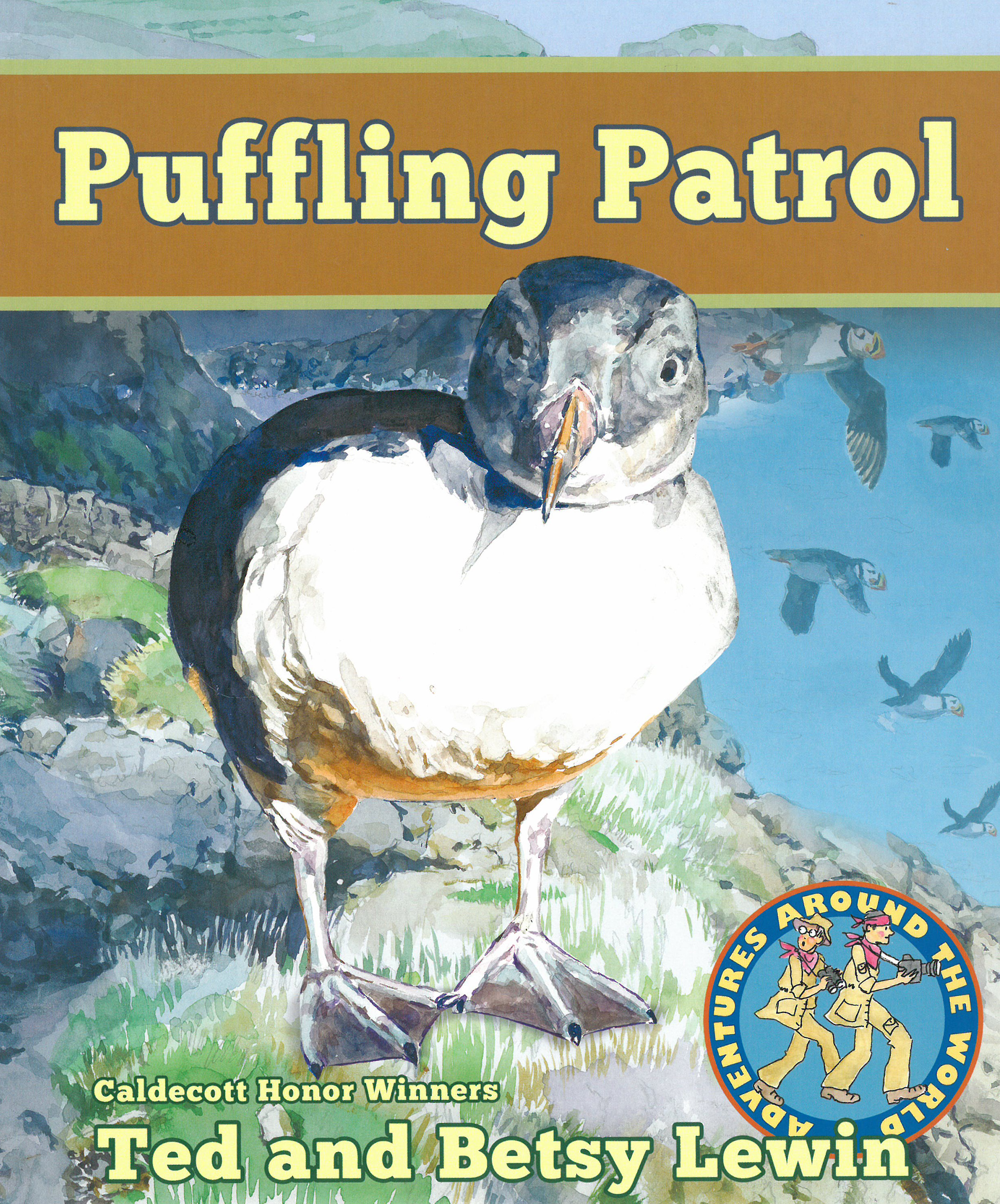
- Rent Party Jazz by written William Miller and illustrated by Charlotte Riley-Webb – Rent day is coming, and Sonny’s mama has lost her job. Sonny isn’t sure what to do, but a jazz musician named Smilin’ Jack hosts a party to help Sonny and his mama raise money for their rent.
- Aani and the Tree Huggers written by Jeannine Atkins and illustrated by Venantius J. Pinto – While Aani sits under her favorite tree, she hears men coming in to cut down the trees, despite protest from the women in the village. When the men return to cut the trees, Aani hugs a tree to prevent them from cutting it down, and the rest of the people in her village follow suit, saving the forest.
For more information about Mix It Up at Lunch Day and how to participate, click here!
Filed under:
Activities and Events,
and Representation,
Book Lists by Topic,
Diversity 102,
Lee & Low Likes Tagged:
African/African American Interest,
Asian/Asian American,
bilingual books,
Book Lists by Topic,
Children's Book Press,
Latino/Hispanic/Mexican,
LGBT,
multicultural books 


By:
Jason Low,
on 10/22/2014
Blog:
The Open Book
(
Login to Add to MyJacketFlap)
JacketFlap tags:
diversity,
multicultural books,
Race issues,
Fairs/Conventions,
Diversity, Race, and Representation,
Activities and Events,
recap post,
Add a tag
On October 11, 2014, I attended a colloquium called Mind the Gaps, hosted by The Horn Book at Simmons College in Boston. There was an all-star line up consisting of Peter Brown (Mr. Tiger Goes Wild), Gene Luen Yang (Boxers and Saints), Andrew Smith (Grasshopper Jungle), and Steve Sheinkin (The Port Chicago 50), to name a few. Roger Sutton, Editor in Chief of The Horn Book, played a big part in pulling all these folks together for a day.
One of the highlights was the keynote by author/librarian Vaunda Micheaux Nelson (No Crystal Stair). Here’s a snippet from her speech:
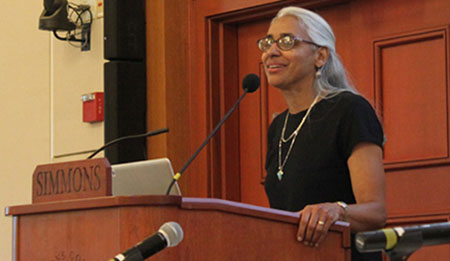
Keynote speaker, Vaunda Micheaux Nelson. Photo credit: Shara Hardeson
“We are here at Simmons trying to solve this problem while one of the biggest stories in the news is that Apple released a new iPhone. Yet ALA struggles to get a one-minute spot on one network to announce the nation’s most prestigious children’s book awards. Is this our world now? To quote one of my favorite library patrons, ‘Have we dumbed down society so much that what is truly significant is not considered important?’ This conversation is significant. So how do we make it important?”
I participated in was called Publishing for the Gaps. The other panelists were Arthur Levine, publisher of Arthur A. Levine Books at Scholastic but more famously known for bringing Harry Potter to the United States, and Ginee Seo, children’s book director of Chronicle Books. The moderator was Roger Sutton. We covered a lot of ground, from the acquisition process to responding to Roger’s charge that publishers often put out “derivative crap” (Roger’s words, not mine) when it comes to blatantly duplicating what works. This statement was met with Arthur’s vehement defense that he sorely doubted that publishing executives would order their editors to make “more derivative crap!”
While I have been on many panels over the years, what was nice about this one was that the audience of 150 was predominately white. Non-diverse audiences like this usually benefit from hearing about the diversity problem, since some may be hearing about it for the first time. Publishing for the Gaps for me is about publishing the stories about people who are left out, which are most often people of color. I discussed LEE & LOW’s efforts to offer clarity and perspective, to help define the scope of why diversity is met with obstacles across most media channels, and how this remains a society-wide problem.

(L-R) Arthur Levine, Jason Low. Photo credit: Shara Hardeson
From the editorial side, the lack of representation can be greatly improved by decision makers who feel a personal stake in publishing diverse books. Ginee, as one of the few Asian American women at an executive level, can and does make a difference. Arthur Levine remarked that it was a part of who he is (as an openly gay and Jewish man) to publish inclusively.
The panel was recorded and is an hour. Note: Since the video is stored on Simmons College’s Google drive you’ll have to log in to view it. I also apologize in advance for the sound quality.
When the colloquium was over, I asked one of the moderators, Nina Lindsay, how she thought the day went. She said, “I was pleased with the colloquium, but feel like we just got the conversation started, then everyone went home. I’m hoping the momentum continues to build on this, and that we don’t all suddenly assume we’re enlightened and part ways.”
Recap of Publishers Weekly Diversity Panel, October 16, 2014
Filed under:
Activities and Events,
Diversity, Race, and Representation,
Fairs/Conventions,
recap post Tagged:
diversity,
multicultural books,
Race issues 

Our Discover Your World Summer Reading Extravaganza Series has come to an end and we are SO grateful for the participation and wonderful guest posts from our contributors.
I truly feel that that series was a success, and it wouldn’t have been possible without our contributors fun and fresh kidlit book picks and activities. We are already percolating on ideas for next summer’s reading event!
Below is a list of all of the posts links and bloggers who participated and I encourage everyone to take a peek to see if you missed any and re-read and enjoy and favorites. There were SO many great contributions this summer and we will be working feverishly to put these posts into a free downloadable document to share (more details to come on that). 

Shannon Medisky:Stand Tall, But Read All Around

Leanna @ Multicultural Kids Blog: Read Around The World Summer Series

Unconventional Librarian: Brown Girl Dreaming

Shannon Medisky-Dancing Differently:’

Gladys Elizabeth Barbieri: WISH

Discovering the World Through My Son’s Eyes: Fiesta Fiasco by Ann Whitford Paul {Guest Post by Frances from Discovering the World Through Her Son’s Eyes}

If You Were Me and Lived in…by Carole P. Roman {Guest Post from Squishable Baby}

Discovering The Cree Culture in America-Wild Berries by Julia Flett Review & Activity! (Guest Post from Felicia at Stanley and Katrina)

Erik at This Kid Reviews: Peter Lerangis’ Seven Wonder series

Cooking with Books: Lucky Birthday Noodles {Guest Post by Jodie from Growing Book by Book}

Discover Your World Summer Reading Extravaganza: Anna Hibiscus by Atinuke {Guest Post by Sprout’s Bookshelf}

A Peek into Thailand {Guest Post from Stephanie Kammeraad of Mama-Lady Books}

A Chair for My Mother Book Review & Activity {Guest Post from Vicki Arnold}

The Magic Poof-A Visit with Author Stephen Hodges.

Until next summer, keep “discovering your world” through books!
The post Discover Your World Summer Reading Extravaganza Series Recap appeared first on Jump Into A Book.

By:
keilinh,
on 9/9/2014
Blog:
The Open Book
(
Login to Add to MyJacketFlap)
JacketFlap tags:
children's books,
Book News,
New Releases,
multicultural books,
fall books,
Muhammad Yunus,
diverse books,
fall releases,
Melba Doretta Liston,
Add a tag
The temperature has already started to drop and we’re seeing Halloween candy popping up in the grocery stores, so that means a new batch of books for the fall season! Here are three new picture books out this week. We can’t wait to hear what you think of them!
Lend a Hand: Poems About Giving
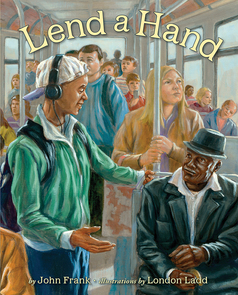
Ages 6–10 • $17.95 hardcover
978-1-60060-970-1
Lend a Hand is a collection of fourteen original poems, each emphasizing the compassion and the joy of giving. Representing diverse voices—different ages and backgrounds—the collection shows the bridging of boundaries between people who are often perceived as being different from one another. Written by John Frank and illustrated by London Ladd.
“At once familiar and slightly out of the box, these giving scenes gently suggest that the smallest acts can inspire and achieve great ends.” —Kirkus Reviews
Little Melba and Her Big Trombone
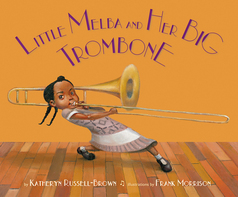
Ages 6–10 • $18.95 hardcover
978-1-60060-898-8
With three starred reviews (PW, School Library Journal, Kirkus Reviews), it’s clear that Melba Doretta Liston is “something special”! Brimming with ebullience and the joy of making music, Little Melba and Her Big Trombone is a fitting tribute to a trailblazing musician and a great unsung hero of jazz. Written by Katheryn Russell-Brown and illustrated by Frank Morrison.
“An excellent match of breezy text and dynamic illustrations tells an exhilarating story.”
—starred review, School Library Journal
Twenty-Two Cents: Muhammad Yunus and the Village Bank
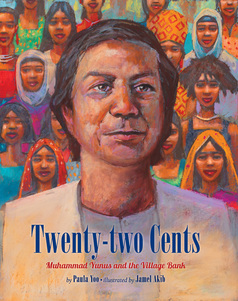
Ages 6–10 • $18.95 hardcover
978-1-60060-658-8
Twenty-two Cents is an inspiring story of economic innovation and a celebration of how one person—like one small loan—can make a positive difference in the lives of many. Written by Paula Yoo and illustrated by Jamel Akib.
“Yoo makes the significance of Yunus’s contributions understandable, relevant, and immediate.” —Publishers Weekly
Filed under:
Book News,
New Releases Tagged:
children's books,
diverse books,
fall books,
fall releases,
Melba Doretta Liston,
Muhammad Yunus,
multicultural books 

I received a copy of this series in exchange for a thorough and honest review. The opinions stated herein are 100% my own. This post contains an affiliate link.
***

Do you like going on trips, getting packed up, and discovering new and exciting things? I certainly do. I love meeting new people, learning a new language and experiencing new food!
Here is a way of doing all that and more – minus the packing up and getting on a plane part!
Before we go, how about we make a passport to keep track of all the new places we venture to? Don’t forget to grab your passports and put it in your suitcase. We are going to need it since we are going on a trip around the world!
Carole P. Roman’s new series, If you were Me and Lived in… is a child’s journey around the world. It’s a fun way of learning about different customs, including those from France, Portugal, Russia, Australia, Turkey, India, Kenya, Norway, and South Korea.
When you first open the book, your child will see a map of the country and it’s capital city. Then, it will show him/her where it is located on the globe. The author then gives information a child would be interested in, such as – friends names, what they would eat when they visit, what you would call your mom and dad, popular places to visit, and special holidays and happenings. In the back of each book, it hows how to pronounce each word – so they can say it correctly!
All of the books in this series are interactive. It asks questions…
When Daddy tucks in at night, you always say; “Amo-te paizinho (a-mo-te pa-i-nho)
Can you guess what you are saying to your pai (pay)?
In the list of definitions in the back, it will give your child the answer.
For my family, these books were a great jumping off point for acquiring further information. In the book on France, the author talked a bit about Bastille Day. So, from there, we talked about the French Revolution and Marie Antoinette. I don’t know about your kids, but my kids love to learn about a good beheading.
Sigh.
If you are adventurous in the kitchen, the author talks about the food your child will experience. If you look up some new recipes on the internet, it will add value to the experience. In the book on Kenya, she talks about Chapati being served with a barbecue of beef or goat called nyama choma and mixed vegetables. It can be made very simply.
My Children’s Favorite If Your Were Me and Lived In… Book

My children’s favorite book was If You Were Me and Lived in…Kenya. They read it over and over. They immediately identified that all the people in this book were brown, which I thought was very interesting.
We learned all kinds of fascinating things about Kenya! One thing mom liked, most of the toys would be handmade. When we visit Kenya, the kids would be creating their own entertainment by gathering wire, sticks and cloth to make Galimoto. No Nintendo’s, YAY!
Don’t forget to stamp your passport with a drawing of something you learned about the country before you leave. It’s very important so that you child can remember when he or she has been and also make the experience their own!

Lisa aka, The Squishable Baby is primarily interested in the educational development of young children. She is a homeschooling mom to 3 and blogs education, health, and picture books. You can catch her on her blog – The Squishable Baby or on Facebook or Pinterest.
The post If you were Me and Lived in…by Carole P. Roman {Guest Post from Squishable Baby} appeared first on Jump Into A Book.
Summers are so crazy-busy-hectic for our family, and I am sure we are not the only ones. I will have to say that we all take great comfort in being able to “power down” after a busy day of being outside or participating in activities and snuggle up with a good book or a great article that inspires us to want to try something new. This week I have discovered a plethora of fabulous ideas and here are some of my top picks:
The Read Around the World Summer Series is going strong over at Multicultural Kids Blog (use hastag #ReadtheWorldMKB on Twitter to find more awesome multicultural reads) and there’s been some delightful contributions to this event this week:

The Story of “Ibong Adarna” – SMART TINKER

Learn the Swahili Alphabet with Jambo Means Hello at Look! We’re Learning!
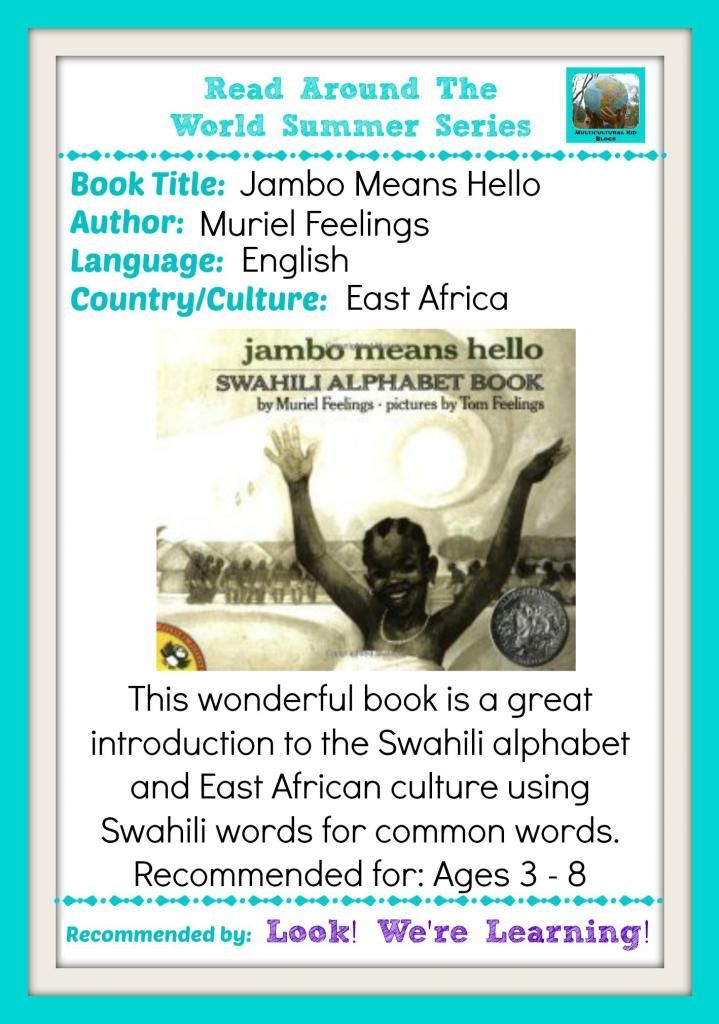
Bedtime routines around the world at Aisha the Indian Princess

We did one too! Here is Jump Into a Book’s contribution to the Read Around the World Summer Series.

Jump Into a Book also welcomed a very special guest post from Mary at Sprout’s Bookshelf for the Discover Your World Summer Reading Extravaganza: Anna Hibiscus by Atinuke {Guest Post by Sprout’s Bookshelf}

Becky over at Kid World Citizen called my attention to a wonderful cause this week too. Every 500 views they donate a special indestructible soccer ball to a community in need! Click here for more details.

What great links have you found this week?
The post Weekend Links: Multicultural Books Links for Kids appeared first on Jump Into A Book.

Our Discover Your World Summer Reading Extravaganza is rolling right along and I am truly hoping JIAB has shown reading families some wonderfulnew summer reading ideas thanks to the amazing book bloggers who have graced the pages of this blog over the last month and a half.
Today is no exception and I am pleased to have Mary Kinser from Sprout’s Bookshelf join us with her take on a great multicultural book called Anna Hibiscus. Thank you, Mary!

In my house, we’re always on the lookout for fun, interesting kid’s books set in Africa. Fortunately there are lots more on the shelves these days than there used to be. Unfortunately many are too advanced for my five-year-old Sprout, or they deal with topics that he’s just not ready for yet.
So you can imagine how thrilled I was to find the Anna Hibiscus books by Atinuke. This is a funny, upbeat series set in modern-day Africa, featuring a multi-racial, multi-generational family. How much more awesome could you get?? And even more fortunately, Anna Hibiscus is geared toward the younger spectrum of readers, which means these work as read-alouds for kiddos my age, and as great stories for emerging readers as well.

Anna Hibiscus features adorable illustrations of Anna and her family – her mother, who is Canadian, and her father, who is African, plus her extended family and baby brothers, twins named Double and Trouble. I love the feeling of family and community the pictures give – breaking down any barriers readers might experience when thinking about life in Africa, and showing the common themes that run through any small child’s everyday world. Each story in the book tells about a different aspect of Anna Hibiscus’ life, whether it’s watching her mischievous brothers while on vacation, or preparing the house for a visit from a favorite Auntie. There are lots of sweet moments and plenty of laughs too – enough to keep kiddos wanting to turn pages.
Atinuke, the author of the Anna Hibiscus titles, is a Nigerian storyteller. Like Anna Hibiscus, Atinuke lived much of her early life in a big house in Africa filled with extended family. But later she moved to England to attend boarding school, and England became her home. She wrote the Anna Hibiscus books in an effort to share stories about growing up in Africa with children from the UK. And luckily for all of us, the books have spread to the US as well.
I love reading the Anna Hibiscus stories with Sprout. His eyes light up as we read about life in Africa (Atinuke doesn’t define what country Anna Hibiscus is from – which works for us, as it could easily be Ethiopia, the land of Sprout’s heritage!). It’s so great to share stories that are on his level, that present a positive family dynamic and show so many commonalities between everyday life no matter where you’re raised. Truly, when you read about Anna Hibiscus and her incredible family, you just want to join in the fun!
There are currently six books in the Anna Hibiscus series, and each is even more charming than the last. But our hearts will always belong to the first book, just titled Anna Hibiscus, which we read on vacation last summer and have continued to love ever since. In fact, as I’m writing this post, Sprout saw our copy of Anna Hibiscus sitting by my computer and yelled, “I love this book!”. So what better endorsement could you ask for?
Activity
The last story in Anna Hibiscus is all about our heroine’s deep desire to see snow. And even though I’m not much of a crafty mom, I did stumble across a perfect idea to connect with the reading by doing an activity with Sprout. Jump over to Red Ted Art to find this great tutorial on making a homemade snow globe. It’s simple and fun, a great chance for kids to get creative and even satisfies that longing to see snow that sometimes crops up on a hot summer day!

Sprout wanted to make his snow globe Star Wars-themed – hence the LEGO Luke Skywalker – and as such we opted to put in silver stars and moons (made from foil) rather than snow. (And since Sprout’s in a big dinosaur phase, he had to add an Apatosaurus figure too. ‘Cause even Jedis can get a little help from a prehistoric pal.) You could absolutely go the traditional route with a holiday theme and some glitter, in keeping with Anna Hibiscus’s wish to see the white stuff. Here’s a few pics of our snow globe in action – it was pretty hard to get good pics because the second we put this bad boy together, Sprout was shaking it up constantly!

Bio
By day, Mary Kinser is a Collection Development Librarian. By night, she’s a curator for Zoobean. And all around the clock she’s the mother of a gorgeous five-year-old boy from Ethiopia, lovingly nicknamed Sprout. She writes about diversity and adoption in children’s literature at her blog Sprout’s Bookshelf. You can also find her on Facebook, Twitter, and pinning all things kidlit at Pinterest.
The post Discover Your World Summer Reading Extravaganza: Anna Hibiscus by Atinuke {Guest Post by Sprout’s Bookshelf} appeared first on Jump Into A Book.

By:
keilinh,
on 5/13/2014
Blog:
The Open Book
(
Login to Add to MyJacketFlap)
JacketFlap tags:
diversity,
booklist,
Resources,
multicultural books,
groundwood books,
webinar,
Diversity Links,
DiYA,
tuttle publishing,
The Diversity Gap,
diverse books,
lorimer books,
Add a tag
Looking for new diverse books for your collection? We’re doing a webinar this afternoon at 2:00 pm EST with Booklist and several diverse publishers – don’t miss it! Sign up free here.
It’s going to be great!
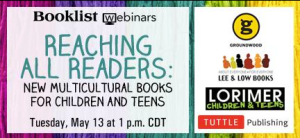
Filed under:
Diversity Links,
DiYA,
Resources,
The Diversity Gap Tagged:
booklist,
diverse books,
diversity,
groundwood books,
lorimer books,
multicultural books,
tuttle publishing,
webinar 


Aldo and family read through Abuelo
Where do stories come from? Sometimes we have to travel to find them, journeying within or experiencing what happens in our paths along the way. Recently I was taking a new book, Abuelo, to Argentina, to people who had inspired it.
People arrive, events occur, that later become essential stories in each of our lives. Clearly, what becomes important is not the same for each person. But often, the stories that happen while we are young stay with us, and can help carry us through the rest of our lives. For my friend Aldo, who is Argentinean, riding La Pampa, the wide plains and foothills of Argentina when he was a boy with his “Abuelo Gaucho”—Grandfather Cowboy—has given him stories, a relationship and a strong place to return to that have helped him ride free through the years.

Granddaughter Victoria and her father Ricardo read Abuelo for the first time.
Aldo’s great grandfather Redmond arrived from Ireland in the 1840′s to a land that “had a lot of beef.” Argentines come in all colors and with names from many cultural backgrounds–from English to Italian, Lebanese to northern European, not just the Hispanic surnames that many associate with Latin America. Aldo explained to me that the popular way to address someone in a friendly way, saying “Che”— something akin to “hello friend”— likely comes from a Guarani Indian word.Like the US, South America is a quilt built of many cultures, from Indian to European to African, and more. But back to Aldo and his young days riding the range with Abuelo Gaucho, that first inspired me to write Abuelo.
As a boy, Aldo lived in a small town in La Pampa where raising cattle was a major enterprise. Cowboys— called gauchos— rode through the streets and sometimes brought herds to load onto the nearby trains. Aldo’s father worked for the railroad. Aldo would see the gauchos in town, and one older gaucho who knew his family well would say to Aldo that he should learn to ride a horse and the ways of the gauchos, that he would teach him. With the permission of Aldo’s family, on Sundays, the gaucho’s day off, the old gaucho began to teach Aldo— first to ride, how to guide and talk to the horse, how to find his way securely on the pampas. Over the years they rode out, the old gaucho on his horse, and Aldo on his own. Grandfather, or Abuelo, Redmond had died before Aldo was born, and so the old gaucho became like a grandfather to Aldo.

Arthur gives Aldo a copy of Abuelo
When Aldo grew up, he moved away from the small town of Roberts and “Abuelo Gaucho” to the city of Rosario to find work at a newspaper, and eventually for a bank. Throughout many changes, Aldo could return to La Pampa and Abuelo Gaucho in his mind. At a bank meeting that was droning on for hours, Aldo, who had been very active and successful in his work, was silent for a time. When someone at the meeting looked at him being so quiet and asked “where is Aldo?” a friend who knew him well said, “he is on La Pampa.” Throughout his life, he has found strength there.
Now in his eighties, Aldo says that relationships between people are most important. His daughter and her family, his grandchildren live nearby. They know some of the great stories of their Abuelo Aldo, and his wife, Abuela Delia, who is a wonderful artist. Among the drawings I admired in their home was one of a gaucho, which thanks to Delia I now have with me. More tales there. I watched as Aldo saw and read Abuelo for the first time. He smiled at connections to places and relationships he has known so well. When I visited granddaughter Victoria’s school, the students, who see gauchos still, recognized the story and beautiful pictures drawn by Raúl Colón, cheered, and raced to tell new tales they found in their own lives— a fountain of youth and stories.
- - - Rating enabled - - -
- - - Comments box activated - - -
Arthur Dorros views being a writer as like being a traveling detective. He finds ideas all around. He learned Spanish while living in Latin America, and many of his stories, such as Abuelo, grow from those experiences. Arthur is the author of many books for children, including Julio’s Magic, a CLASP Américas Award Commended Title; Papá and Me, a Pura Belpré Honor Book, and the popular Let’s-Read-and-Find-Out Science book Ant Cities. He lives in Seattle, Washington.
I tuned into ESPN the other night, clicking away at my laptop as I waited for the Stanford-North Carolina women’s basketball game to begin. The end of the Louisville-Maryland contest was on. There was about a minute left, and Louisville was losing by 10 points, which pretty much guaranteed Maryland the win. But wait. A Louisville player, number 23, floated in a terrific three-point shot with 30 seconds left. Then the same player hit another three-pointer with 18 seconds left. And yet another with five seconds left. Maryland had made two foul shots during the Louisville run, and the score was now 76-73. But it was Louisville’s ball. One more three-pointer would send the game into overtime.
I’m a sucker for an athlete who performs well under pressure, so I put down my laptop and stared at the screen. The announcers were full of praise for the Louisville player, a senior named Shoni Schimmel. I have rarely seen anyone with a smoother, more poetic stroke. When Maryland took a timeout before the game's last play, I went back to my computer and Googled her.
I admit I don’t follow college basketball as much as I should. If I did, I would have known that Shoni, and her sister Jude, who also plays for the University of Louisville, are a genuine phenomenon. Their games attract thousands of people who drive from all over the U.S. and Canada to see them. The sisters are Native Americans who grew up on the Umatilla reservation in Pendleton, Oregon. Their success has galvanized Native fans and even attracted a filmmaker, who made a documentary about them titled Off the Rez.
As I read about the Schimmel sisters, I thought, “This is a great story. I should write it.” You probably know that I’ve made a career bringing the true tales of athletes and other bold and brilliant women to the mainstream. As first Shoni and then Jude graduate from college and enter the WNBA, their journeys should have the makings of a great book.
But then I wondered, “Should I write it?” In recent months, there has been a lot of discussion about the underrepresentation of people of color in children’s books. The postings on multicultural literature on the listserv of the Cooperative Children’s Book Center (CCBC) of the University of Wisconsin, Madison, were coming fast and furious the entire month of February. A few weeks later, Walter Dean Myers and Christopher Myers wrote companion essays in the Sunday Review section of The New York Times under the title, “Where Are the People of Color in Children’s Books?”
One of the strands on the CCBC listserv focused on who actually writes books with characters or subjects of color, and as a corollary, who shouldwrite those books. A number of posters were pretty adamant that they thought books were more authentic—and by extension more acceptable—when they were written by members of the groups they portrayed. By that logic, a book about the Schimmel sisters would be best by a Native person. But why should authors be limited by their backgrounds? I’ve written more than a dozen books, including three biographies, and I’ve never written one with a main character who shares my Jewish heritage. For me, part of the joy of writing nonfiction is getting to explore new worlds while developing the context to tell the story.
That’s what I was thinking as I read many of the CCBC posts. And now I’m finally putting it into words. People expressed a valid concern about getting a more diverse pool of authors (and editors) producing children’s books, but I don’t feel that any authors should be dissuaded from tackling any topics that ignite their passions. Every voice is valid and every perspective is worth considering as we inspire kids' curiosity about and understanding of the world around them.
------------
For the record, Louisville didn’t win the game, despite an inspired play that put the ball in Schimmel’s hands for one more three-point attempt. She shot, and the ball hit the rim and ricocheted away as time ran out. It was Shoni’s last college game, but hopefully the prelude to an exciting professional career. Perhaps someone will write a book about Shoni and her sister one day. Perhaps it will be me.


By:
Hannah,
on 3/21/2014
Blog:
The Open Book
(
Login to Add to MyJacketFlap)
JacketFlap tags:
multicultural,
diversity,
book awards,
publishing,
Bookstores,
resources,
multicultural books,
Diversity Links,
Publishing 101,
colormyshelf,
Add a tag
Recently The New York Times paired articles by Walter Dean Myers and his son Christopher Myers, discussing the lack of representation of people of color in children’s literature. Those excellent articles—which pointed out that in the long history of children’s literature we haven’t made much progress—caught the attention of best-selling author Jennifer Weiner, who started the #colormyshelf hashtag on Twitter asking for suggestions of diverse books that she could go purchase for her daughter. What a wonderful way to bring attention to what parents can do!
Just because diverse books don’t always show up front and center in bookstores doesn’t mean they don’t exist. Here’s a list of places to find great diverse books for young readers. Buy them, read them, recommend them. Showing demand for diverse books is one of the best ways to encourage the publication of more of them!
1. Publishers: Several small publishers (us included) focus on diverse books. They’re a great place to start, and you can usually buy books from them directly, order them through an online retailer like Amazon or Barnes & Noble, or ask your local bookstore to order them (which also displays a demand for diverse titles):
Lee & Low Books (diverse books for young readers featuring a range of cultures)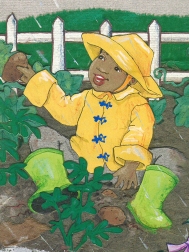
Tu Books, an imprint of Lee & Low (diverse middle grade and young adult speculative fiction)
Children’s Book Press, an imprint of Lee & Low (bilingual English/Spanish picture books)
Cinco Puntos Press (adult and children’s literature, and multicultural and bilingual books from Texas, the Mexican-American border, and Mexico)
Just Us Books (black interest and multicultural books for children and young adults)
Roadrunner Press (fiction and nonfiction for young readers focusing on the American West and America’s Native Nations)
Piñata Books, an imprint of Arte Público (juvenile and young adult books focused on Hispanic culture and by U.S. Hispanic authors)
Groundwood Books (Canadian publisher of books for young readers with a focus on diverse voices)
2. Blogs That Recommend Diverse Books: There are some great bloggers out there who do the hard work of seeking out, reading, and recommending diverse children’s books, so you don’t have to! Just hop over to their blogs to find great new books to add to your collection:
The Brown Bookshelf (African American books)
American Indians in Children’s Literature (Native American books)
Latinos in KidLit (Latino books )
BookDragon (all diverse books, with a special focus on Asian/Pacific Islanders cultures)
Diversity in YA (diverse young adult books)
Rich in Color (diverse books for all young readers)
Crazy QuiltEdi (diverse books for all young readers)
Lee & Low Pinterest Board (diverse books searchable by genre and age)

3. Awards: If you’re simply looking for the best of the best that’s been published each year, awards are the place. Books that win these awards have been vetted by experts (mostly librarians) so you can expect them to be top quality, beautiful, and culturally accurate.
Coretta Scott King Award (African American books)
Pura Belpré Award (Latino books)
Asian/Pacific American Award for Literature
Middle East Book Award
American Indian Youth Literature Award
South Asia Book Award
Américas Book Award (Latin American, Caribbean, and Latino books)
Tomás Rivera Book Award (Mexican American books)
Notable Books for a Global Society (outstanding trade books that help promote understanding across lines of culture, race, sexual orientation, values, and ethnicity)
4. Bookstores: If you prefer to purchase your books through good old-fashioned browsing, there are several great independent bookstores that make it a point to stock diverse books. Below are a few we’ve been to, or that have been recommended to us by readers. If you’re in the area, be sure to stop by to support them!
Avid Bookshop, Athens, GA
Calamus Bookstore, Boston, MA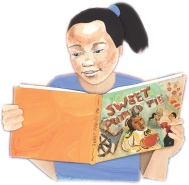
La Casa Azul New York, NY
Quimby’s, Chicago, IL
Women and Children First, Chicago, IL
The Book Stall, Winnetka, IL
Politics and Prose, Washington DC
Busboys and Poets, Washington DC
The Flying Pig Bookstore, Shelburne, VT
Birchbark Books, Minneapolis, MN
Ancestry Books, Minneapolis, MN (coming soon)
Antigone Books, Tucson, AZ
Wellesley Books, Wellesley, MA
Librería Martinez, Santa Ana, CA
What did we miss? Let us know in the comments!
Filed under:
Diversity Links,
Publishing 101 Tagged:
book awards,
Bookstores,
colormyshelf,
diversity,
multicultural,
multicultural books,
publishing,
resources 


By:
Jaclyn DeForge,
on 2/11/2013
Blog:
The Open Book
(
Login to Add to MyJacketFlap)
JacketFlap tags:
Resources,
Reading Aloud,
multicultural books,
Read Alouds,
Educators,
independent reading,
reading comprehension,
common core standards,
Curriculum Corner,
guided reading,
appendix b,
common core standards appendix b,
common core standards ela appendix b,
common core standards language arts appendix b,
exemplar texts appendix B,
smiling dogs,
diversity,
Book Lists,
Add a tag
 Jaclyn DeForge, our Resident Literacy Expert, began her career teaching first and second grade in the South Bronx, and went on to become a literacy coach and earn her Masters of Science in Teaching. In her column she offers teaching and literacy tips for educators.
Jaclyn DeForge, our Resident Literacy Expert, began her career teaching first and second grade in the South Bronx, and went on to become a literacy coach and earn her Masters of Science in Teaching. In her column she offers teaching and literacy tips for educators.
Earlier this week, I had the pleasure of meeting with a literacy expert who was SUPER involved with the creation of the Common Core Standards (!!!!!), and she gave me some important feedback about the Appendix B supplement I posted last week. To refresh your memory, what we’ve done is compiled a supplement to Appendix B that includes both contemporary literature and authors/characters of color, and that also meets the criteria (complexity, quality, range) used by the authors of the Common Core. We were lucky enough to have this literacy expert take a look at our supplement, and she gave some great suggestions:
- The texts selected for Read Aloud can be outside the text complexity bands for each grade cluster.
- Texts that are Read Aloud in lower grades can be read as Independent Reading in upper grades.
We’ve incorporated these ideas into our Appendix B supplement. So, without further ado, click here for a PDF of our new and improved multicultural supplement to the Common Core’s Appendix B.
Know who else is excited about the updated Appendix B list? This guy:
Further Reading:
What’s in your classroom? Rethinking Common Core recommended texts
Why Window and Mirror Books are Important for All Readers
Filed under:
Curriculum Corner,
Resources Tagged:
appendix b,
Book Lists,
common core standards,
common core standards appendix b,
common core standards ela appendix b,
common core standards language arts appendix b,
diversity,
Educators,
exemplar texts appendix B,
guided reading,
independent reading,
multicultural books,
Read Alouds,
Reading Aloud,
reading comprehension,
smiling dogs 

By:
Administrator,
on 12/10/2012
Blog:
Margo Dill's Read These Books and Use Them!
(
Login to Add to MyJacketFlap)
JacketFlap tags:
Journal Writing,
multicultural books,
Middle School Teachers,
Elementary Educators,
High School Teachers,
nonfiction books for teens,
Book Club Possibility,
Helping Girls and Women Around the World,
Debate topics,
Kaolin,
Young Adult Novels,
racism,
Add a tag

Kaolin, the author of Talking About Race (publisher: Crandall, Dostie & Douglass Books, Inc.), contacted me about her book, and I thought it sounded so interesting that I told her to send it to me. And I’m so glad she did. This post is going to be a little different than my normal posts about books you can use with students (you could probably use this with teens and college-age students)–I am going to share the book with you and tell you how to use it, but I will show you examples straight from the pages of the book. I also want to share with you a little of the author’s story. So, here we go. . .
Kaolin was born Patricia Anne Graham, and she legally changed her name to Kaolin with no surname in 1991. She has had many jobs in her life: a waitress, a singer, a writer, and a teacher. She’s worked in adolescent programs with teens with disabilities and in politics. She has also worked on a tree farm. In 1994, she designed and taught a course titled, “Let’s Talk About Race: Confronting Racism Through Education,” which after many years became this book I’m talking about today.
The book is divided into seven chapters with a “writing interval” at the beginning. It is written for “white people working to achieve racial equality in their lives, and to readers of color who would like insight into psychological and social experiences white people encounter.” Personally, I find this perspective fascinating–as a white woman, I never thought it appropriate or even necessary to address the concerns and topics that Kaolin discusses in her book. But after reading it, I see that it is, and I saw myself and my feelings in the pages of her book–especially when I was younger. I can see youth groups, book clubs, college classes, and more reading and studying this book. It will start conversations that need to be had. I hope that I can discuss these issues with my stepson soon and with my daughter when she is older. And as the cover states, it does not just have to be white people–it can be all races working together.
As Kaolin states in her introduction about why she wrote it: “Because learning how to talk about racism is hard. Most of us ‘react’ to it first. . . The lack of thought that has gone into many white people’s position about racism is amazing to me. . . Talking About Race meets that need.”
She begins with recognizing racism with lists that describe what a racist believes and with a section that even addresses, “How do you know you whether or not you are a racist?” The next chapter is titled “Resisting Racism,” which can actually bring up many uncomfortable feelings–especially when children/teens are faced with racism from parents or other loved ones, and they don’t know how to confront these beliefs or even act around the person. Kaolin gives some ideas for figuring this out. She continues this theme in the “Defenses and Insecurities” chapter.
The book goes on through real-life examples and encouraging prose, as well as pages of thinking questions with room to write answers, to face racism head on and understand how it can affect people in a family and in a community. Kaolin forces people to also look at themselves and how behaviors can either promote or stop racism. It’s not a book intended for people to feel bad about themselves or members of their family. It’s a book written to get people talking and thinking and hopefully changing hurtful behaviors.
I highly recommend using Talking About Race with teens and college-age students. I think it is perfect for a home school group, a church youth group, a community group like Boys and Girls Club, and more. It’s well-done!
Here are a few of the questions from it that get adults and children USING the book:
- If you woke up this morning and there had been no racism in your life, how would your life have been different?
- Have you ever feared someone because of his or her color? Have you been fearful of anyone because of your color?
- With respect to your own color, would you say you were born lucky?
- Do you think white people have no problems?
- In order to correct a racist situation, I would need. . .
Check it out on Amazon or at Kaolin’s website if you don’t believe me! 
A message from Literary Agent Adriana Dominguez,
I am happy to send you this message to let you know that, with the help of former publisher of HarperCollins' Latino imprint and current CEO of Mamiverse Rene Alegría's help, yesterday, we launched Mamiverse Books, the only site currently available to promote children's books and reading directly to Latina moms. Take a look: http://www.mamiverse.com/life/mamiverse-books/
This site is the culmination of many years of work in this area, and more than anything else, I hope that it will serve as a valuable resource for first and foremost Latino parents, as well as librarians, book store owners and educators looking for appropriate books for their children. While I do plan on reviewing some non-latino books that I think Latina moms should know about, the strongest emphasis will be placed on reviewing and promoting the work of Latino authors to what we hope will be a broad audience interested in YOUR books. Please join me in this effort by spreading the word in any way you can. Facebook, Tweet, Blog(a), or even that age-old medium email, would be great!
Thank you in advance for your support. Let's hope that this is just the beginning!
Abrazos,
Adriana Domínguez
Full Circle Literary
Here is the press release
National Pledge Drive for Family Commitment to Reading
NEW YORK (October 1st, 2012)--Mamiverse.com, the premiere website for Latina moms and families, announced today the launch of a new book section, Mamiverse Books. The first non-trade oriented, yet comprehensive digital resource for Latino parents wanting to know more about books that accurately reflect the U.S. Latino experience, Mamiverse Books creates a tool for parents who want to foster the love of reading as a road to their children’s academic success. Comprised of book reviews written by industry experts and librarians nationwide, Mamiverse Books will offer author interviews, features and more. Children’s categories will include Picture Books, Middle Grade Books, Young Adult Books and Bilingual books.
In conjunction with the launch of Mamiverse Books, and tied to National Book Month, Mamiverse.comalso announces Mamiverse Reads, an online pledge drive for Latino families that commits them to making reading and books a life-long priority. Families that pledge will receive a formal document they can printout stating their new commitment, along with the latest book news and reviews.
Spearheading Mamiverse Books is renowned Latino children’s book expert, Adriana Dominguez.
“Studies have shown that reading paves the way for future academic success,” says Dominguez. “It is essential that we provide families with quality resources that specifically address the needs of Latino parents who want direction on how to incorporate books and reading into their children’s lives. The sooner children are exposed to books, and encouraged to read on a consistent basis, the more likely it is that they will do well in school.”
“We are very lucky to have Adriana lead this important initiative,” says Founder and CEO of Mamiverse.comRene Alegria. “Our aim is to make books and reading the basis for a life-long commitment to goal-oriented success. Families who read together, achieve together.”
Hispanic Children in Education, by the Numbers:
● One out of four babies born in the U.S. is Latino. (U.S. Census)
● One in four kids currently in public school are Hispanic. (Pew Center Research)
● 48.8% of Hispanics 25 and older do not have a high school education, 2010. (American Community Survey)
● Percentage of 18-24 year old Hispanics in college reached record share of 16.5%. (Pew Center Research)
● There are one million Hispanics with advanced degrees. (Pew Center Research)
● Hispanics are the largest ethnic minority with 50.5 million people. (U.S. Census)
● Projected Hispanic population by 2050, 132.8 million. (U.S. Census)
(Adriana Dominguez is available for interviews)
About Adriana Dominguez
Adriana Dominguez is considered an expert in the field of children books appearing in the media and on publishing panels nationwide to speak on the topic of books and the Latino community. She has 15 years of experience in publishing, most recently as Executive Editor at HarperCollins Children’s Books, where she managed the children’s division of the Latino imprint, Rayo. Prior to that, she was Children’s Reviews Editor at Críticas magazine, published by Library Journal. Adriana has also worked as an editorial consultant for children’s and adult publishers, on English and Spanish language books. A professional translator, who has worked on a number of translations of best-selling and award-winning children’s books, she has also worked as a literary agent for some time. Adriana is mom to a very active and curious toddler who keeps her busy, and makes her exceptionally happy.
About mamiverse.com
Mamiverse.com is the premiere site dedicated to Latina moms and families. Launched in July of 2011, Mamiverse.com was created to better inform this rapidly growing online community. By empowering Latina moms with the tools they need, and by reaching all Hispanic women and their families in the process, Mamiverse.com connects this powerful and passionate group of family-influencers, with a culturally relevant outlet that understands who they are, what they need, and how they think. With a rotating roster of high-profile contributors, and features on news and trends of the day, Mamiverse.com keeps readers engaged and informed. In addition to revolving news coverage, Mamiverse.com addresses a growing list of key topics including: food, health, politics, money, school and style. Twitter Handles: @MAMIVERSE, @MamiverseBooks
I have so many books to review that it’s time to do a round up! First, I must apologize to all three of these lovely authors that it has taken me this long to mention your books and showcase them on my blog. I am working on a new, better system (aren’t we all?), so that I will not get so backed up in the future. Anyway, let’s get on to these lovely books. I will share a brief summary, who should read, and a couple discussion points for them. Here we go!
 Chigger by Raymond Bial is a well-written book with a touch of humor about a new girl moving into town (in Southern Indiana) in the 1950s, and she is not readily accepted, especially moving in April and starting school “about seven months late.” She insists on being called Eddie and on wearing jeans to school, and she cusses (word of warning–read this book before your children/students to make sure you are okay with language or want to talk to them about it), and fights. So, she’s not your typical girl, which makes her a great literary character! The point of view character has a great voice–he’s a fifth-grade boy, Luke, so this book will appeal to boys (it’s probably more upper mid-grade or tween), and he kind of likes this new girl, which makes him a great character, too. She gets the nickname Chigger from a humorous character, Buzz, because “you’re just a dang bug and you sure get under my skin.”
Chigger by Raymond Bial is a well-written book with a touch of humor about a new girl moving into town (in Southern Indiana) in the 1950s, and she is not readily accepted, especially moving in April and starting school “about seven months late.” She insists on being called Eddie and on wearing jeans to school, and she cusses (word of warning–read this book before your children/students to make sure you are okay with language or want to talk to them about it), and fights. So, she’s not your typical girl, which makes her a great literary character! The point of view character has a great voice–he’s a fifth-grade boy, Luke, so this book will appeal to boys (it’s probably more upper mid-grade or tween), and he kind of likes this new girl, which makes him a great character, too. She gets the nickname Chigger from a humorous character, Buzz, because “you’re just a dang bug and you sure get under my skin.”
This book has some serious issues in it and is inspired by actual events. Chigger is obviously poor and always hungry, although she is super independent. She and her mom are running from an abusive father. She is picked on and ostracized for being different and new. It also explores friendship and standing up for what’s right. I see this as the perfect book for a parent and child to read together and discuss because it will bring up issues that the child may be dealing with in a non-threatening way!
 The Wild Soccer Bunch Book 3: Zoe the Fearless by Joachim Masannek and illustrated by Jan Brick is part of a series of books titled, The Wild Soccer Bunch. These books are endorsed by a professional soccer player, Landon Donovan, and have quite a bit of merchandise to go with them, which can be found on an extensive website here. In the third super cute book, Zoe’s mother has passed away, and she and her father are moving to Chicago. Zoe wants to play on the boys’ team–not on the girls–and so her father signs her up with the Wild Soccer Bunch, who aren’t too crazy about playing with a girl. She has to prove herself. Plus there’s Grandma, who is busy trying to get Zoe to be more like a girl.
The Wild Soccer Bunch Book 3: Zoe the Fearless by Joachim Masannek and illustrated by Jan Brick is part of a series of books titled, The Wild Soccer Bunch. These books are endorsed by a professional soccer player, Landon Donovan, and have quite a bit of merchandise to go with them, which can be found on an extensive website here. In the third super cute book, Zoe’s mother has passed away, and she and her father are moving to Chicago. Zoe wants to play on the boys’ team–not on the girls–and so her father signs her up with the Wild Soccer Bunch, who aren’t too crazy about playing with a girl. She has to prove herself. Plus there’s Grandma, who is busy trying to get Zoe to be more like a girl.
Obviously this is the perfect book for anyone who likes soccer. (There are quite a few illustrations, so this would probably be beg. middle-grade/maybe even chapter book.) I also like it because it showcases girls in sports. We all know girls play and love sports! So why not have a book to celebrate this?! You can discuss all sorts of things with this book, including death and dying, sportsmanship, moving, practice for sports (hard work), individuality, being true to yourself, and more.
 Pipper’s Secret Ingredient by Jane Murphy and Allison Fingerhuthand illustrated by Neal Sharp is a delightful chapter book with plenty of illustrations for readers who are ready to step into something harder than a picture book, but still feeling apprehensive about reading novels. Pipper is a dog who blogs! She blogs about food–of course–and the book starts out with her blog. She is actually looking for an interesting blog post topic, and she decides that she will search for a secret ingredient. As she travels around and blogs, she visits some interesting places such as Egypt, New York City, Paris, and the Orient Express. She has her friends, too, a cast of characters who readers are introduced to in the very beginning that help her with her adventure.
Pipper’s Secret Ingredient by Jane Murphy and Allison Fingerhuthand illustrated by Neal Sharp is a delightful chapter book with plenty of illustrations for readers who are ready to step into something harder than a picture book, but still feeling apprehensive about reading novels. Pipper is a dog who blogs! She blogs about food–of course–and the book starts out with her blog. She is actually looking for an interesting blog post topic, and she decides that she will search for a secret ingredient. As she travels around and blogs, she visits some interesting places such as Egypt, New York City, Paris, and the Orient Express. She has her friends, too, a cast of characters who readers are introduced to in the very beginning that help her with her adventure.
This is the perfect book for children to learn more about places all over the world, blogging and using the Internet for research, and what is truly important to an individual. I’m telling you that kids will LOVE THIS BOOK! I love holding it and looking at it. It is so shiny. You definitely don’t want to miss this!
By:
Administrator,
on 10/24/2011
Blog:
Margo Dill's Read These Books and Use Them!
(
Login to Add to MyJacketFlap)
JacketFlap tags:
Reece Colleen L,
Journal Writing,
Middle Grade Novel,
multicultural books,
middle grade historical fiction,
Middle School Teachers,
Elementary Educators,
Making Personal Connections,
Research Ideas,
Books With Social Studies Content,
Writing Skills,
World War II books,
historical fiction for kids,
Book Club Possibility,
Helping Girls and Women Around the World,
Add a tag

*Middle-grade historical fiction with Christian themes (WWII)
*13-year-old girl as main character
*Rating: Last Page in the Diary will really appeal to girls who like historical fiction and like writing in their diaries. It is a great book to use in a home school or Christian school setting as so many tweens deal with this question: “How can God let bad things happen?” This book is especially great because it also teaches about history!
Short, short summary:
(From the
Guardian Angel Publishing website (sorry! I am pressed for time tonight.): “Thirteen-year-old Patricia (Pat) Kelly bargains with God. If He will bring her best friend Mike (Yoshi Mizuki) home from a desert (Japanse Internment) prison camp and make things like they were before the war, maybe she can start trusting Him again. The war ends, but hate and persecution continue.” (There’s also a part of this book written in journal style!)
So what do I do with this book?
1. If students do not know much about the period of history this book covers, then have them research different things mentioned in the book, such as Pearl Harbor Day or the Japanese Internment Camps. Students can write reports, do Power Point presentations, create posters, or some other way to share information with students.
2. Have readers ever felt the way Pat or Mike do in the novel–either with their relationship with God or as a victim of bullying/racism? These are great journal writing topics and discussion topics for tweens. Through the characters in this book, tweens may feel more comfortable talking about and/or writing about these issues and comparing/contrasting their experiences with the ones in the novel.
3. If students were involved in an essay contest, what would they write about? And why? You can even hold your own essay contest if you want to. . .:)
Kindness speaks the words, Your heart could never speak. Your wings hold me up, And give me strength when I am weak. The warmth of your protection, Brings music to my heart. You open up the doors, You show me where to start. ~ Anne Marie Cline In last week’s Bur Bur and Friends multicultural [...]
View Next 25 Posts






 Stacy Whitman is Editorial Director and Publisher of
Stacy Whitman is Editorial Director and Publisher of 









 And then there’s the stark imprint of privilege found in the gaps and silences of
And then there’s the stark imprint of privilege found in the gaps and silences of 







 instead decides to give his money to a homeless man.
instead decides to give his money to a homeless man. Passage to Freedom
Passage to Freedom





















































.jpg)




Okay, we all know by now that we need more Diversity Books in American public schools, a category that Tu Books focuses upon it. It’s somehow complex to follow all the appendixes mentioned here, but I took a brief look at Appendix D for grades 9-12. I saw books about African American, Chinese, Native American and LGBT. But didn’t see nay book (maybe I missed it) for American Latinos who are about 25% of the students at American Public Schools.
Also as an outsider to the education system I wonder if the US Education Department gives the list of books that teacher can teach, or it’s up for teacher to make their own list.
Hi Giora-
Yes, there are a lot of appendices to study for selecting texts for students. In a few words, Appendix A is useful for learning about what makes a text complex for readers. Appendix B offers examples that teachers have used with success in their classrooms within grade bands. While Teaching Tolerance does plan to build out its text exemplars (so books with Latino characters and authors will surely be included), the real goal of this Appendix D tool is to support teachers in becoming their own list-makers. Teachers ultimately know their students’ reading levels, interests, demographics, and experiences better than any group or institution drafting and recommending a book list can. There are many groups and institutions that provide teachers lists of book recommendations, but this new Apppendix D tool will enable teachers to learn how to look at a text and determine that it is both high-quality AND provides the perspective that will reflect and celebrate their students. We are very impressed with Teaching Tolerance’s commitment to keeping our educators in the driver’s seat!